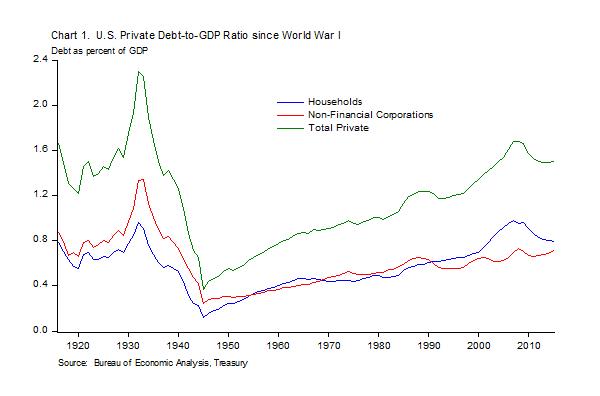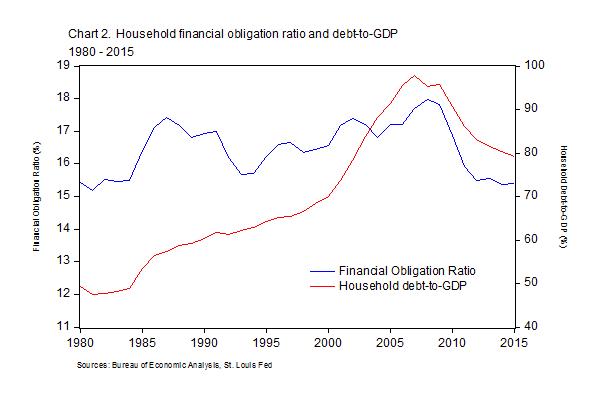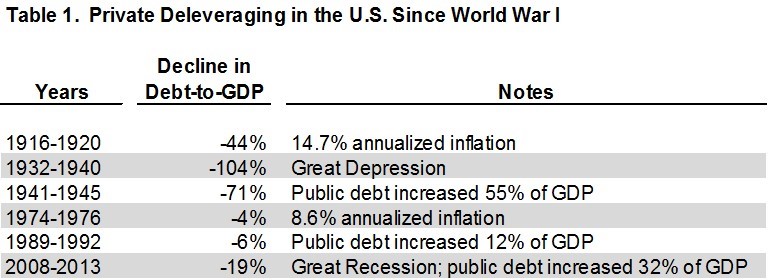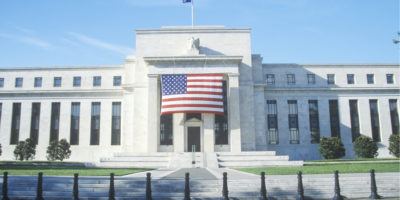Private Debt: How Much is Too Much?
A Precarious Position
Richard Vague, author of The Next Economic Disaster, points to a common trend among the worst recessions and depressions of the past century: private debt totaling over 150 percent of GDP, and an increase in that ratio by at least 18 percent over the previous five years. This was true of the run-ups to the Great Depression, Japan in the 1990s, and the 2008 crisis.
Chart 1 tracks U.S. private debt, and its components household and nonfinancial corporate debt, over the last century. Private debt stands at 150 percent of GDP, but fell by 8 percent from 2010 to 2015. According to Vague’s signals, overall private debt is high enough that if there were another run-up, there would be cause for concern. However, whether this level of private debt is problematic in and of itself is still an open question that we will examine below.
Since World War II, the trend in private debt has been almost uniformly upward, with two periods of deleveraging that were small relative to the overall level of debt. Private debt fell from 124 percent to 118 percent of GDP during the recession of the early 1990s, and from 168 percent to 149 percent in the Great Recession. That the latter event, which was such a massive shock to our economy, led to only a small adjustment in the level of private debt is perhaps a surprise.
Chart 2 compares household debt from the previous chart to the financial obligation ratio, which equals quarterly scheduled mortgage and other debt payments divided by quarterly income. The financial obligation ratio is a measure of households’ ability to make debt payments. While overall debt declined only to its 2002 level after the financial crisis, the financial obligation ratio fell to the lowest level since 1980. The difference is that the financial obligation ratio accounts for our current extremely low interest rates. This underscores an important point about the risk of debt: while consumers may be able to meet obligations now, they might have far greater difficulty should interest rates rise.
Dangers of Private Debt
Our modern economy could not function without borrowing and lending, and hence private debt. Moreover, short-term growth is commonly associated with the expansion of private debt, leading to constant upward pressure that is evident in chart 1. Knowing ex ante exactly how much private debt is too much is difficult, but excessive private debt leads to several problems.
Private debt can lead to or exacerbate economic crises. It can do so by leaving households and businesses more exposed and vulnerable to economic shocks, as in the case of excessive mortgage debt when home prices began to fall in the 2008 crisis. It can also trigger crises, if lender concerns cause them to stop rolling over debt, leading to liquidity and ultimately solvency problems for households and businesses.
Private debt can also slow the economy even in times of overall growth. As Vague notes, “Money that would otherwise be spent on things such as business investment, cars, homes, and vacations is increasingly diverted to making payments on the growing debt—especially among middle- and lower-income groups that compose most of our population and whose spending is necessary to drive economic growth. Debt, once accumulated, constrains demand.”
Finally, perhaps the most concerning aspect of private debt is what it takes to lower it. As Vague and others note, a reduction in private debt almost always comes with at least one of four events: an increase in public debt, high inflation, a trade surplus, or a recession or depression. The United States has not had a significant trade surplus in almost 100 years. This means the options for private deleveraging are to substitute government debt, inflate it away, or let households practice their own version of austerity by spending less and slowing the overall economy.
Table 1 confirms these stark choices. Since World War I, there have been only six instances where private debt has fallen as a percentage of GDP for two or more years. In each case, the reduction came with one of the undesirable choices above. If one believes that private debt cannot simply rise forever, it follows that we will face these difficult choices down the road.
What Can Be Done?
The need to significantly reduce private debt is not obvious, but it is noteworthy that we are hovering around 150 percent of GDP, the risky threshold in Richard Vague’s analysis. As already discussed, private deleveraging involves no painless choices. Vague proposes various types of debt restructuring, which might be particularly effective for underwater mortgages, but such plans are politically difficult to implement.
What can be done is for the government to not encourage disproportionate run-ups in private debt in the future. When the Fed keeps interest rates artificially low, as it has ever since the 2008 financial crisis, it encourages households and businesses to borrow more. Furthermore, the Austrian theory of the business cycle predicts that governments’ inflationary policies will encourage private debt higher than the equilibrium level by interfering with individuals’ and businesses’ economic calculations. When governments and central banks pump more money into the economy, it appears to businesses that there are more funds available for production and investment, leading to overcapacity, debt, and ultimately recessions.
The government’s policies to encourage home ownership have had perhaps the most unintended consequences of any policy with respect to private debt. Since the early 1990s, government-backed mortgage lenders like Fannie Mae and Freddie Mac were required to make a quota of their loans (originally 30 percent, raised to 50 percent under President Clinton and 55 percent under President Bush) to borrowers below the median incomes in their communities. By 2008, 70 percent of the outstanding subprime mortgages were on the books of these government enterprises rather than the private sector. To appreciate the significance of these policies in causing the Great Recession, recall Vague’s signal of a private debt-to-GDP ratio run-up of at least 18 percent in the five years before a crisis. From 2002 through 2007, the ratio increased by 22 percent of GDP; household mortgage debt alone was responsible for a 20 percent increase. Policies designed to help low-income Americans own homes ended up disproportionately harming them as they became stuck with underwater mortgages or joining the ranks of those made unemployed because of the recession.
Private debt is a necessary and inevitable part of our economy, but history shows that high levels and sudden increases bring about significant risk of economic crises. While it remains to be seen whether our current level of private debt is problematic, we are not likely to deleverage without other significant negative consequences. In the future, policy makers should be mindful of the medium- and long-term consequences of action meant to help people in the short run.











